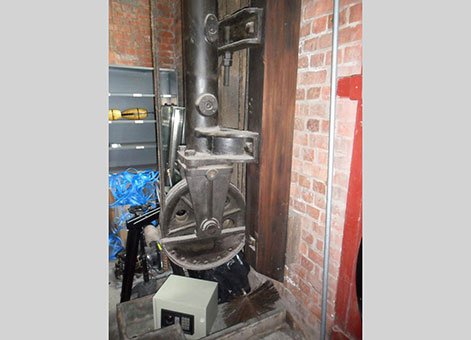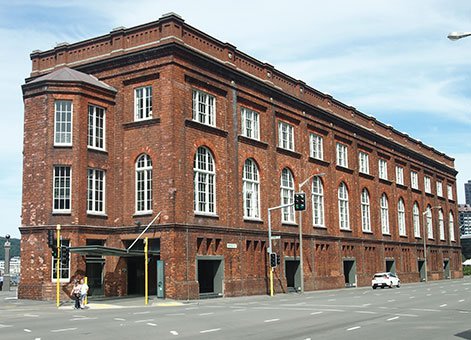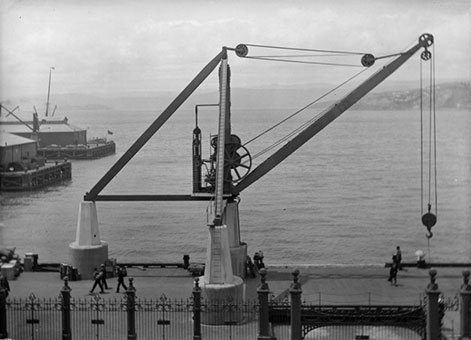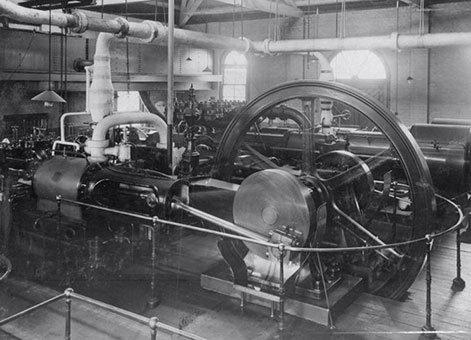The Wellington Harbour Board’s hydraulic power system was important to the operations of this significant New Zealand port from the late 19th to mid-20th centuries.
William Ferguson was appointed Engineer and Secretary to the Wellington Harbour Board (WHB) in 1884, and Treasurer some time later. He quickly gained the confidence of the WHB, which was reflected in his salary being raised to what was then a very generous sum of £1,000 per annum. Ferguson soon began to develop the Port of Wellington’s infrastructure, which became the envy of other New Zealand ports. At the core of the Port of Wellington’s success was its brilliant hydraulic power system.

The lower sheaves of the wastern whim - Shed 13, Wellington, 2011. Image courtesy of B. Comfort.
It was not until 1885 that New Zealand’s first industrial application of electricity was commissioned at Bullendale in Central Otago. Wellington became the first New Zealand city to have a public electricity supply in 1889. The WHB’s hydraulic power system was initiated in 1887 and was fully operational by 1889. In comparison, the first electric port crane in Auckland was installed in 1910.
The WHB hydraulic power system eventually serviced most of the Lambton Harbour waterfront, from the north at Railway Wharf, through to the main wharf, Queens Wharf, and subsequently to the Taranaki Street Wharf at the southern side of the harbour.
The WHB’s system pumping station had pumps powered by steam engines. These engines pumped water into hydraulic accumulators, enabling this water to be maintained under pressure. The hydraulic accumulators featured a vertical cylinder, piston and rod, with a crosshead and twin weights supported from the ends of the crosshead.

Shed 21, Waterloo Quay, Wellington, February 2014. Engineering New Zealand.
An accumulator was housed at the north end of the former WHB wharf offices/Shed 7 at Queens Wharf, and in 1908 a second accumulator was added to the system. This one, housed at the northern end of what was Shed 21. Water was pumped into the system under pressure so that weights were raised near to the top of the piston stroke. The weights maintained the pressure in the system with fluctuating load until they reach a preset lower level, whereupon the pumps restored water to the system. The accumulators were connected to a flow and return piped reticulation through which water was circulated.
The first components for the system were ordered from the United Kingdom. The initial equipment included three fixed wharf cranes, three movable cranes, three moveable winches, a wool press, six traversers in storage sheds and six jiggers used for storing at heights. A crane capable of lifting 35 tons was on the Te Aro reclamation. Subsequently local firms like Luke and Sons and William Cable and Company manufactured them.
Hydrants were provided for connection of portable port equipment, like winches and some cranes. Permanent connections were also made to static equipment such as cranes, lifts, traversers, capstans, jiggers and wool presses.

Wellington waterfront, showing wrought iron gates, wharves, and Wellington Harbour Board crane on quay [circa 1900]. Halse, Frederick James, d 1936: Collection of negatives. Ref: 1/2-004078-G. Alexander Turnbull Library, Wellington, New Zealand.
The hydraulic system proved cost effective. Previously the port equipment had been operated by individual steam engines and associated boilers. As a result of the hydraulic power system coal consumption was greatly reduced and insurance premiums were correspondingly lowered by 30 per cent because of the reduced fire risk. In addition, the cranes cut unloading time by as much as 50 per cent and meant fewer employees were required.
The last of the hydraulically powered equipment was withdrawn from service at the port in 1954.
Regrettably not much of this remarkable installation remains except for an intact shed hoisting (jigger) system comprising two whims and all the associated counterweights, static cables hauling cables and sheaves in Shed 13, and the accumulator guide rails in former Shed 21 (now an apartment building).

Interior of pumping station, circa 1912. Wellington City Archives, Reference: 2006/7:0:64 Wellington Harbour Board, Small Album 2.
Heritage recognition
Buildings with hydraulic system remnants have been recognised by Heritage New Zealand as Category 1 historic places (List no.236 and 237):
Wellington Harbour Board Shed 13: New Zealand Heritage List/Rarangi Korero information.
Wellington Harbour Board Shed 21: New Zealand Heritage List/Rarangi Korero information.
More information
Access
The accumulator tower (guide rails only) are visible in the hexagonal brick tower housing the staircase to the apartments in Shed 21. Two very complete whims can be viewed at Shed 13 (Offices of Mojo Coffee Company) by inquiring.
References
David Johnson, Wellington Harbour, Wellington, 1996.
J Gibson and M Pierce, ‘Remnants of Early Hydraulic Power Systems,’ Proceedings of the 3rd Australasian Heritage Engineering Conference, 2009.
Location
Lambton Harbour's former Wellington port area.
